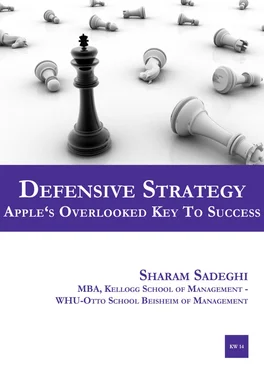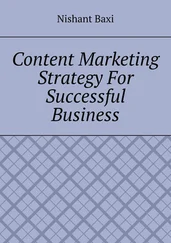The objective of this work is to examine, why having a defense system in place, for immediate and appropriate response, is crucial for successful companies to sustain their profitability and position in the market at the same time. We will further analyze why leading incumbents fail to respond to offensive threats and lose their right to exist. Moreover, we will discuss the defensive strategies and tactics a company might utilize, when under attack. To visualize the need for and the effectiveness of successful defensive strategies, we will start with Apple as the best practice example.
Why Apple?
The company from Cupertino gets a lot of credit for being an innovative and cool brand. The purity in design, seamless interaction between hardware and software, as well as, the unique user-experience are usually its top-three key success factors highlighted. But, while that might be true, it is not the real secret behind its success: The underestimated and often overlooked truth lies in the way of how Apple protects its innovations. Along the example, we will focus on its iPod and iTunes business and discuss how Apple obtained the lead in both, the digital music market, and digital media player segment at the same time. Furthermore, we will analyze the tactics of how the Cupertino-based company has succeeded in retaining its leading position in both segments, which helped Apple on its way to become the business world’s most valuable brand of today.
2. Defensive Strategy – The Apple Way of (i)Defense
In 2011, Apple sold 147 million post-PC devices (iPod, iPhone, and iPad), accounting for 75% of the company’s annual revenue (including sales from related products and services). With $6.3 billion, the iTunes store contributes 6% of Apple’s total net sales, [5]where we can already assume a prospective growth potential in correlation with the increased sales of the post-PC device category on one, and penetration of the iTunes software installment base on the other side. By the end of 2011, the company counted 357 own retail stores, generating $14.13 billion revenue, that is 13% of its total sales revenue. [6]The reported net income in the fiscal year 2011 was $25.9 billion, equivalent to an increase of +85% vs. fiscal year 2010. [7]Finally, with a market cap of about $500 billion, Apple is more valuable than Exxon Mobil by $100 billion, as reported by Fortune magazine in its June 2012 issue. [8]
The success story of Apple is a story of a company that has revolutionized a variety of industries, from personal computers, music, mobile phones, tablet computing, digital publishing, and mono-brand retail business. It has achieved this position by attacking the core of an existing segment (e.g. portable music devices and legal digital music distribution), or by creating a new, redefined segment (e.g. smartphones, tablets). At the same time, the success in existing and new categories increases the company’s vulnerability through a number of different flanks that will and already have become targets of competition from a variety of industries. Thus, the company is only able to sustain its leading position by having the right defense strategies and tactics implemented to protect its diverse flanks.
In the further course of this work, we will focus on the era from 2001 until today, and examine the defensive moves Apple has taken to protect its business. Here, we will focus mainly on its iPod category (including the business generated by the iTunes Store) that represented nearly 50% of Apple’s sales revenue in 2006, before iPhone was launched in 2007. As we will see, most of the key strategic moves and tactical patterns that helped Apple to strengthen its iPod business are now protecting its post-PC fortress, including the iPhone and iPad category. To understand why the company is there, where it is today, it is essential to know where it came from.
2.1 A Company in Transformation: From Apple Computer, Inc. to Apple Inc.
“Victory in our industry is spelled survival. The way we’re going to survive is to innovate our way out of this.” Steve Jobs, Interview with TIME in 2001
Apple Computer, Inc. was officially founded by Steven Paul Jobs, a 21-year-old college dropout working at Atari, and Steve “Woz” Wozniak, a 26-year-old employee of Hewlett-Packard, on April 1, 1976. Ronald Wayne, a third founder, left the company, after less than two weeks. He sold his share of the newly created company for just $800, three months after its inception. [9]Both, “Woz” as the technical genius, and Jobs as the creative and visionary mind, created the foundation of what is known today as the most desirable and successful brand in business history.
The first product of the newly formed company was Apple I, a computer that was hand-built by co-founder Steve Wozniak in Steve Jobs’ parents’ garage and first introduced in 1976. More than 200 units of Apple I were sold as a kit for $666. [10]In the following year, in April 1977, Apple II, a further improved version of the first Apple Computer, was introduced as a more elaborate and cosmetically polished machine looking more like a conventional PC. [11]Inspired by what Jobs had seen during his visit of Xerox’s PARC research lab in Palo Alto, California in 1979, Apple introduced Lisa in January 1983, a computer with features and, for the first time, a user-friendly graphical user interface (GUI) that later became standard. However, being launched at a premium price of $10,000 Lisa failed to penetrate the market and thus lacked commercial success. In January 1984, the first Apple computer was introduced under the name Macintosh, at a price of $2,495. It was the first affordable personal computer, equipped with a GUI and innovative operating system, the Mac OS. The launch of the “insanely great” product, a terminology often used by Jobs to characterize the uniqueness of Apple products, was accompanied by a prominent Superbowl ad, directed by Ridley Scott, who is known as the director of the Hollywood blockbuster movie Alien. [12]
The Macintosh became a real success. With its simplicity and plug-and-play approach, it offered a complete desktop solution to its customers. The growing PC market, at the time, was driven by IBM and compatible products. At the same time, prices for hardware started to drop constantly, making Apple appear as overpriced to customers. As a reaction to this development, John Scully, Apple’s new CEO who had been brought in by Jobs himself in 1985, attempted to move the company into the mainstream market, by becoming a low-cost producer, attracting the mass market. The disagreement regarding the “new” strategy driven by Scully, led to Steve Jobs being forced to leave the company in 1985. As a result of turbulent business performance, Michael Spindler was announced to replace Scully as CEO in 1993. Spindler changed Scully’s direction, started licensing to various companies to produce Mac clones (away from the original DNA), focused on cost-cutting, and fell behind against Microsoft’s Windows OS. [13]In 1996, Michael Spindler, the “vision-free” successor of Scully, was replaced by the third, “post-Jobs” CEO, Gilbert Amelio. Without Jobs, Apple was dramatically failing, especially enforced by the inconsistency and missing commitment to a clear (long-term) strategy. Scully, Spindler and Amelio were not able to turn around the company, which resulted in over $1.6 billion losses for Apple, in fiscal year 1996-’97. Gil Amelio, the CEO at the time, was not even able to sell the company, as deals with potential buyers, IBM and Sun Microsystems, fell through. Apple was about to run out of cash and into bankruptcy. Amelio, however, made a great move, as he paid $400 million to acquire NeXT, Steve Job’s next company, after he had left Apple in 1985. The software and patent properties, attached to the acquisition, set the foundation for the upcoming and successful operating system of the new Macs of today. But, more importantly, he could convince Jobs to join Apple again as interim CEO and advisor in 1997, to become the official CEO three years later, in 2000.
Читать дальше












